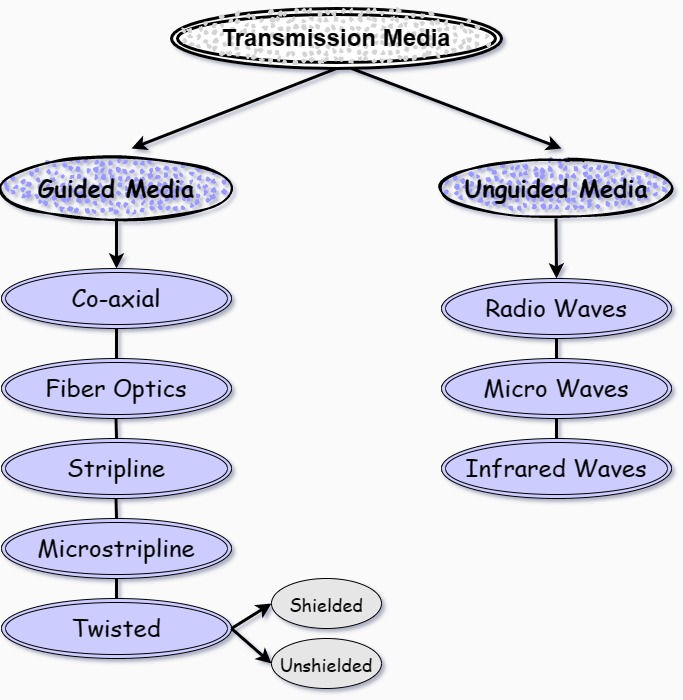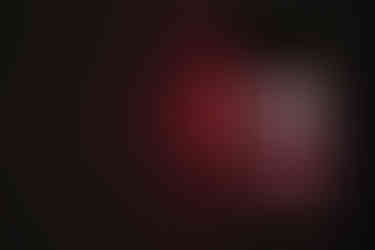Try guessing ' THE TYPES OF TRANSMISSION MEDIA'?
- Fathima Ahla

- Jan 22, 2023
- 4 min read
Done guys??
Now check out with us to see if you are right !!!

What is Transmission Media in Computer Network?
Transmission media is a communication channel that transmits information from the source/transmitter to the receiver. It is a physical path for data transfer through electromagnetic signals. Information is carried over in the form of bits through LAN. It can mediate the propagation of signals for telecommunication. Signals are imposed on a wave that is suitable for the chosen medium. These media lie underneath the physical layer that regulates them.
Tables of Content
Types of Transmission Media In Computer Network The two main types of transmission media in computer networks are:
Guided media and
Unguided media.
So, are you right guys?
Whether a "Yes" or a "no", lets dig more. Here we go!

Classification of the types of transmission media chart.
Wondering the difference between guided media and Unguided media?
Simple. Guided media requires physical medium to communicate whereas, unguided media requires air.
Guided Transmission Media
Guided (wired /bounded) media physically connect the sender and the receiver through wires over a shorter distance. Signals are transmitted in a narrow pathway by the usage of physical links, in order to transfer data.
But the limitation in this method is that due to the usage of wires, signals that flow through this media are limited and hence this method is applicable only for short distances.
The five types of guided transmission media are;
Twisted Pair Cable.
Optical Fiber Cable.
Coaxial cable.
Stripline.
Microstripline.
Twisted Pair Cable.
These are the most commonly used transmission medium cables. They comprise of two insulated conductors of a single circuit, which are twisted and packed together in protective sheaths.
This protective sheath protects the conductors from external electromagnetic interference and minimizes electromagnetic radiation thereby preventing the same signal being shared by two or more signaling pathways. It also prevents pairing between the neighboring pair by reducing electromagnetic radiations.
They are of two types;
Unshielded pair cables and
Shielded twisted pair cables.
Unshielded Twisted Pair Cable(UTP)
This is a pair of insulated copper wires coiled together, which provides a high-speed link while effectively blocking interference with no physical shield.
Advantages
Cheap.
Easy to install.
High speed.
Disadvantages
Due to the loss of signal strength in cables (attenuation) applicable only to short-distance communication.
Vulnerable to external interference.
Applications
Telephonic applications.
Shielded Twisted Pair (STP).
These kind of twisted cable provides insulation allowing greater data transmission rate as they consist of a foil shield to block external interference.
Advantages
Greater data transmission rates can be achieved.
Minimized crosstalk. Faster than UTP.
Disadvantages
Bulky and expensive. Difficult to install.
Applications
Fast data rate ethernet.
Data and voice channels of telephone lines.
Optical Fiber Cable
Optical fiber cable/ fiber optic cable are thin strands of glass consisting numerous optical fibers within which guide light both unidirectionally and bidirectionally along their length.
These cables are capable of transmitting large amounts of data for longer distance without signal repeaters.
Advantages
Lesser requirements.
Less maintenance costs.
Higher reliability.
Can be used for long distance communications.
Increased bandwidth. Protects against interference.
Disadvantages
High-cost.
Fragile.
Applications
When transferring large volume of data.
Coaxial cable
These cables are made of PVC or Teflon material and consist of two parallel conductors separately insulated. The dimension of these cables and connectors are managed in a manner to give them constant conductor spacing improving efficiency.
This transmission line transmits data in two modes, namely the baseband mode and the broadband mode.
Advantages
Capable of carrying high frequency electrical signals without major loss.
High bandwidth. Noise immunity.
Disadvantages
Totally collapse when a single cable fails
Applications
Cable TVs.
Analog TV.

Stripline
Striplines are transverse electromagnetic transmission media (TEM) which is found on the inner layers of multi-layer printed circuit boards, which reduces emissions, provides protection from incoming false signals and traps electromagnetic radiation within homogeneous dielectrics.
Radio frequency signals that should be quarantined from surrounding circuitry uses striplines. In this transmission media the signal trace is trapped between the upper and lower ground place, hence its a type of printed circuit transmission line.
Advantages
Better isolation. Minimized loss of radiation.
Disadvantages
Complex troubleshooting. Expensive.
Applications
Solid-state microwave systems.
Microstripline
Microstripline are used to convert microwave frequency signals hence is used in microwave components like antennas, filters, power dividers etc.. Unlike stripline these are not trapped between the upper and lower ground place, instead present above the ground plane.
Substrate is a dielectric layer separating the conductor and the ground layer. These can be constructed with any technology.
When comparing with the traditional waveguide technology, these are cheap.
Advantages
Easy interconnection and adjustments. Major fabrication advantage over stripline due to its open structure.
Disadvantages
Only applicable for a short distance.
Applications
Solid-state microwave systems.
Unguided Transmission Media
Unguided Transmission (unbounded /wireless) media does not require a physical media like guided transmission media to communicate , they transmit electromagnetic signals through air and do not connect the sender and receiver physically.
Advantage.
Used for longer distances communication purposes.
Disadvantage.
Less secure than guided media.
The three main types of unguided transmission media are;
Radio Waves
Microwaves
Infrared/ IR rays
Radio Waves
Radio waves are waves of frequency range between 3 kHz to 1GHz, which are transmitted from one sender to many receivers, hence its omnidirectional that is, it travels in all directions. These waves are received by antennas. These waves are capable of penetrating walls, buildings etc. and covers a large range of communication.
Advantages
Easy to generate. Can penetrate obstacles.
Disadvantages
More interference.
When another signal with the same bandwidth or frequency is sent interference might arise.
Applications
Cordless phones.
AM/FM radios.
Microwaves
This is also known as line-of-sight transmission as it is important for the transmitter and receiver antenna to be aligned. These waves consist of electromagnetic waves with a frequency range between 1-400 GHz and facilitates a bandwidth range of 1-10 Mbps.
More the height of the antenna more the distance covered. Usually these are suitable for shorter distances.
They are of two types, namely;
Terrestrial microwave transmission and
Satellite type microwave transmission.
Applications
Mobile phones, televisions
Terrestrial type microwave transmission.
High directional, parabolic antennas of diameter ranging from 12 inches to feet are used for line of sight propagation paths that consume frequency between 4-12 GHz.
Satellite type microwave transmission.
When compared to guided media this is a much more flexible and reliable method of communication.
In this transmission medium satellites act as repeaters, that is, they only capture signals and retransmits them to the appropriate locations.
Infrared These are electro magnetic waves of frequency range between 300GHz – 400THz and are suitable only for very short distance communication.
Advantages
Larger bandwidth therefore very high data rates.
More secure.
Less interference.
Disadvantages
Cannot penetrate obstacles.
Applications
Wireless mouse, printers, keyboards.














Comments